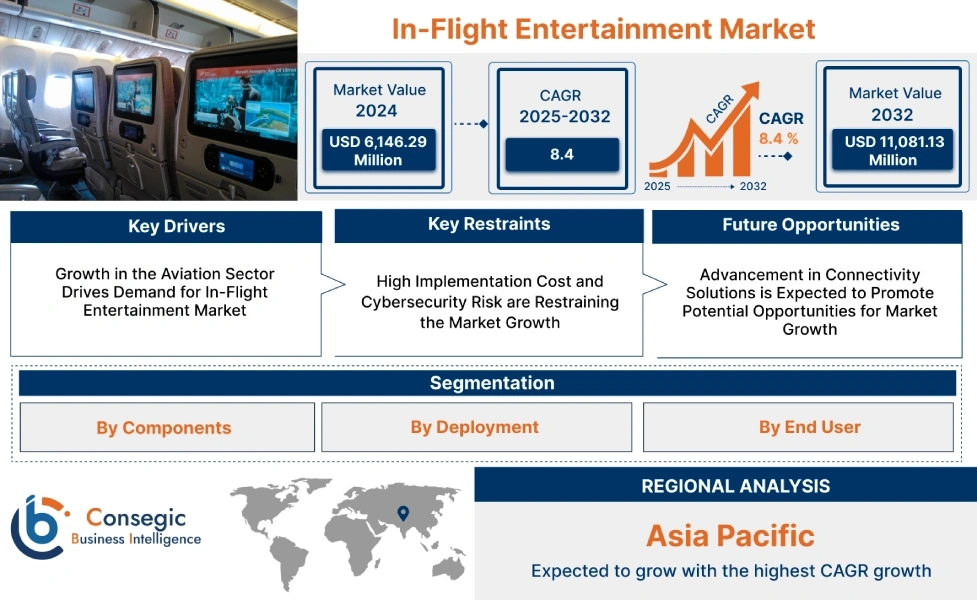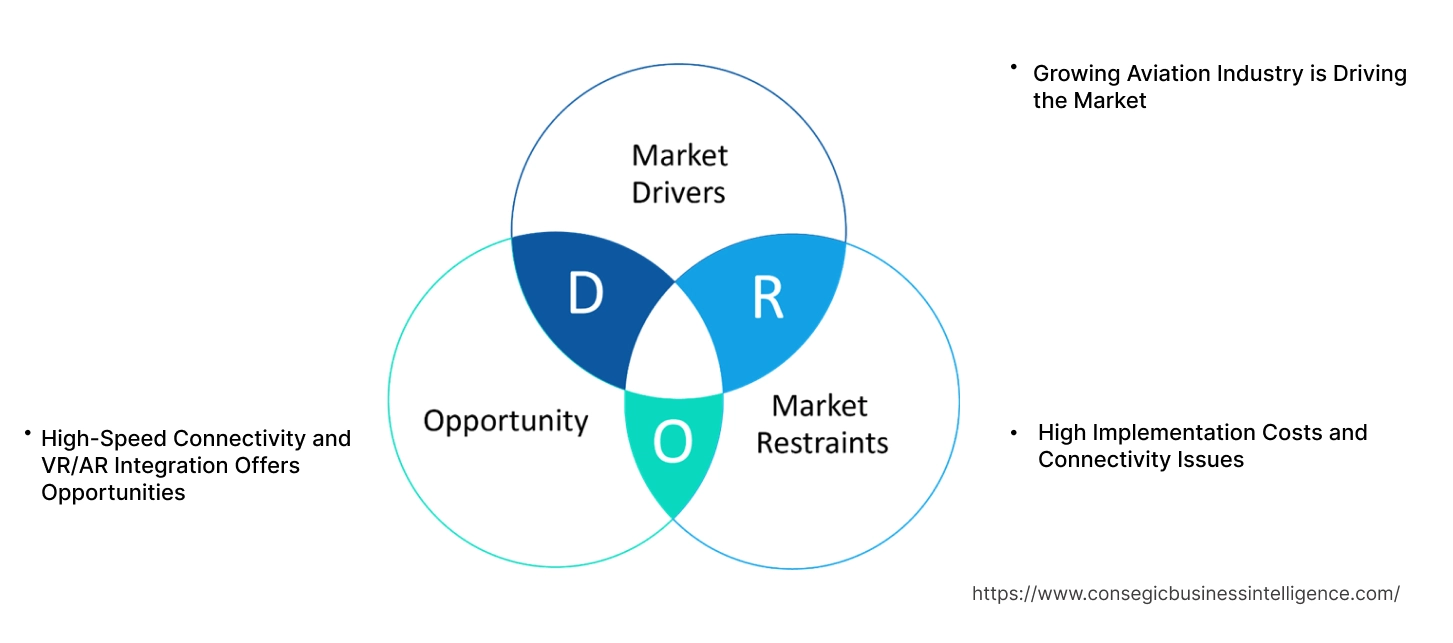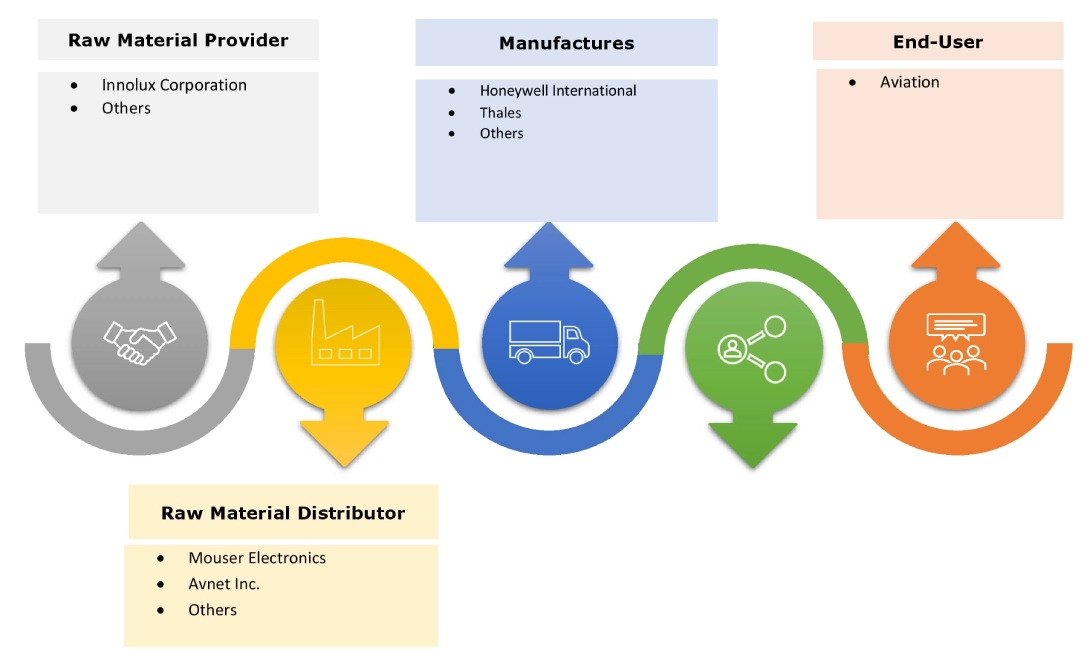In-Flight Entertainment Market Size:
In-Flight Entertainment Market size is estimated to reach over USD 11,081.13 Million by 2032 from a value of USD 6,146.29 Million in 2024 and is projected to grow by USD 6,509.29 Million in 2025, growing at a CAGR of 8.4% from 2025 to 2032
In-Flight Entertainment Market Scope & Overview:
In-flight entertainment refers to the wide variety of solutions and services offered to airline passengers during a flight. The entertainment includes movies, TV shows, music, games, and others, which in turn is driving the in-flight entertainment market demand. Additionally, the key advantages include enhanced travel experience, improved passenger satisfaction, improved brand loyalty, and others which in turn boost the in-flight entertainment market growth. Further, the integration of AR/VR and the adoption of cloud-based systems are boosting the in-flight entertainment industry. Furthermore, advancements in technology, such as high-definition displays and virtual reality (VR), are also contributing to the evolution of IFE systems.
In-Flight Entertainment Market Dynamics - (DRO) :
Key Drivers:
Growth in the Aviation Sector Drives Demand for In-Flight Entertainment Market
The surging need for air travel is prompting airlines to invest in advanced IFE systems to enhance passenger experience, improve customer satisfaction, and differentiate themselves from competitors, which in turn is boosting the in-flight entertainment market growth. Additionally, the increasing focus on prioritizing passenger comfort and satisfaction is propelling the in-flight entertainment market demand. Further, innovations in high-speed internet connectivity, 4K displays, and interactive touchscreens are enhancing the functionality and appeal of the system which in turn is boosting the market progress.
- For instance, in January 2024, according to Boeing, the South Asian aviation market is growing significantly and is planning to add more than 2,700 planes over 20 years due to the expanding aviation sector across the region.
Therefore, the growth of the aviation sector is driving the need for entertainment systems, in turn, proliferating the progress of the market.
Key Restraints:
High Implementation Cost and Cybersecurity Risk are Restraining the Market Growth
The hardware and software require substantial capital expenditure, which in turn is hindering the in-flight entertainment market expansion. Additionally, the system is susceptible to cyber-attacks which leads to the exposure of customers data, which in turn is restraining the market progress. Further, various international standards and safety regulations are restraining businesses from adopting advanced technologies for airplanes.
Therefore, the high implementation cost and cybersecurity risk are hindering the in-flight entertainment market expansion.
Future Opportunities :
Advancement in Connectivity Solutions is Expected to Promote Potential Opportunities for Market Growth
The integration of 5G and satellite communications is becoming increasingly crucial for providing seamless communication between devices which in turn is paving the way for in-flight entertainment market opportunities. Additionally, the increasing demand for high-speed internet and seamless digital experiences during flights is propelling the market evolution. Further, innovations in satellite communication and wireless networking are boosting the market progress.
- For instance, in April 2025, Cathay Pacific announced to offer 100% seatback inflight entertainment as well as high-speed inflight connectivity across its fleet by August 2025 which in turn is expected to create a competitive advantage in the market.
Hence, the integration of 5G and satellite communications is anticipated to increase the utilization, in turn promoting prospects for in-flight entertainment market opportunities during the forecast period.
In-Flight Entertainment Market Segmental Analysis :
By Component:
Based on the component, the market is segmented into hardware, software, connectivity, and content.
Trends in the Component:
- The trend towards the adoption of user-friendly interfaces for easy navigation and content selection is driving the need for hardware components.
- The demand for reliable and fast internet connectivity due to the adoption of advanced satellite technologies is boosting the hardware segment.
Hardware accounted for the largest revenue share in the year 2024.
- The hardware component comprises screens, controllers, audio systems, and others.
- Additionally, the rising demand for higher resolution displays in flights is driving the progress of the hardware segment.
- Further, the airlines are increasingly prioritizing robust in-flight connectivity solutions to meet the demands of modern passengers, which in turn is driving the need for the hardware segment.
- Furthermore, the increasing focus on reducing energy consumption is propelling the adoption of miniaturized hardware components in flight.
- For instance, in December 2024, Air India extended Vista Stream, which is a wireless in-flight entertainment service, to ensure uninterrupted entertainment for passengers. Also, the Vista Stream is embedded on aircraft across the international and domestic networks.
- Thus, as per the market analysis, the increasing focus on reducing energy consumption and the need for higher resolution displays are driving the market progress.
Connectivity is anticipated to register the fastest CAGR during the forecast period.
- The connectivity segment encompasses air-to-ground connectivity and satellite connectivity.
- Additionally, advancements in satellite technology are providing more reliable and high-speed internet access across wider geographical areas is propelling the market progress.
- Further, the proliferation of 5G is revolutionizing the in-flight internet experience, which in turn is boosting the connectivity segment.
- Therefore, as per the market analysis, the proliferation of 5G is anticipated to boost the market during the forecast period.
By Deployment:
Based on the deployment, the market is segmented into embedded system, portable system, and wireless streaming system.
Trends in the Deployment:
- The trend towards rising adoption of cloud platforms which allow real-time content delivery and reduce device weight is driving the wireless streaming systems deployment in flights.
- The trend towards the rise of BYOD (bring your own device) is driving the need for portable systems.
Embedded Systems accounted for the largest revenue share in the year 2024.
- Embedded systems play a crucial role in delivering a seamless and intuitive user experience, with personalized content recommendations is fueling the adoption of systems in flights.
- Additionally, the rising need for miniaturized and energy-efficient embedded systems to improve fuel efficiency is driving the market progress.
- Further, the rising adoption of wide aircraft and business jets is propelling the deployment of embedded systems for providing seamless entertainment.
- For instance, Panasonic offers Astrova which is a next-generation in-flight entertainment system with features such as 4K displays, high-speed internet, and others which in turn aim to enhance the passenger experience.
- Thus, as per the market analysis, the rising need for miniaturized and energy-efficient embedded systems is driving the market progress.
Wireless Streaming Systems is anticipated to register the fastest CAGR during the forecast period.
- Wireless streaming systems refer to the deployment of media content over wireless networks, allowing users to access and enjoy media without physical connections.
- Additionally, the need for a personalized and flexible entertainment experience in flight is fueling the market progress.
- Further, advancements in Wi-Fi technology, such as Wi-Fi 6 and 6E, are propelling the adoption of wireless streaming systems, which in turn is fueling the in-flight entertainment market size.
- Therefore, as per the market analysis, the advancements in Wi-Fi technology, such as Wi-Fi 6 and 6E, are anticipated to boost the growth of the market during the forecast period.
By Aircraft Type:
Based on the aircraft type, the market is segmented into narrow-body, wide body, and business jets.
Trends in the Aircraft Type:
- The wide-body aircraft have the capability to provide high-speed internet, QLED displays, and a wide array of entertainment solutions due to a long journey which in turn is driving the in-flight entertainment market trends.
- The rising focus on customization in business jets to enhance the passenger experience and interactive experiences is driving the in-flight entertainment market trends.
Narrow-body aircraft accounted for the largest revenue share of 51.22% in the year 2024.
- The narrow-body aircraft are designed for shorter distances and are commonly used for routes where utilization is lower due to fewer passengers.
- Additionally, the rising need for short-haul paths, connecting smaller cities and regional airports, is boosting the adoption of narrow-body aircraft.
- Further, the growing middle class, as well as increased disposable income, is driving the need for narrow-body aircraft, which in turn fuels the in-flight entertainment market share.
- For instance, in October 2024, Riyadh Air ordered 60 Airbus A321neo jets. The investment aims to expand the Saudi aviation sector with a highly fuel-efficient fleet as well as align with sustainability goals.
- Thus, according to the in-flight entertainment market analysis, the growing middle class, as well as increased disposable income, is driving the market progress.
Business Jets is anticipated to register the fastest CAGR during the forecast period.
- Business jets are time-saving solutions for long-distance travel as compared to commercial flights, which in turn boosts the rise of business jets.
- Additionally, the jets are integrated with advanced satellite communication technologies to provide faster internet speeds for streaming and other data-intensive applications, which in turn fuels the in-flight entertainment market size.
- Further, the increased business travel and a desire for personalized experiences are boosting the in-flight entertainment market share.
- Therefore, according to the in-flight entertainment market analysis, the increased business travel and a desire for personalized experiences are anticipated to boost the market during the forecast period.
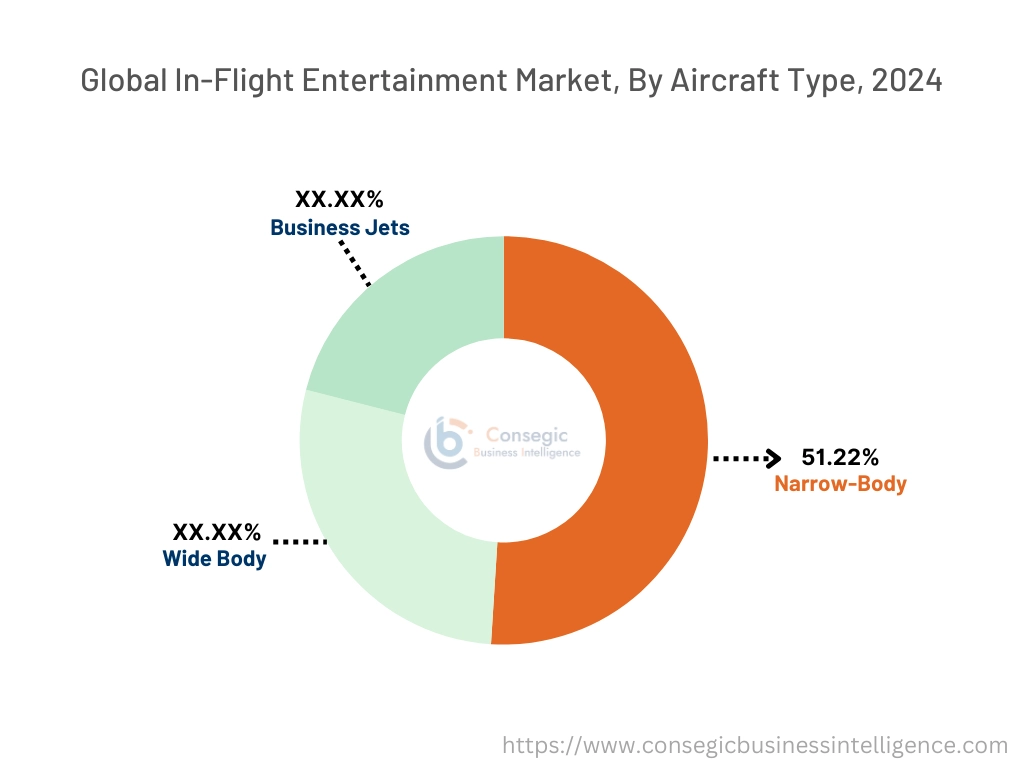
Regional Analysis:
The regions covered are North America, Europe, Asia Pacific, Middle East and Africa, and Latin America.
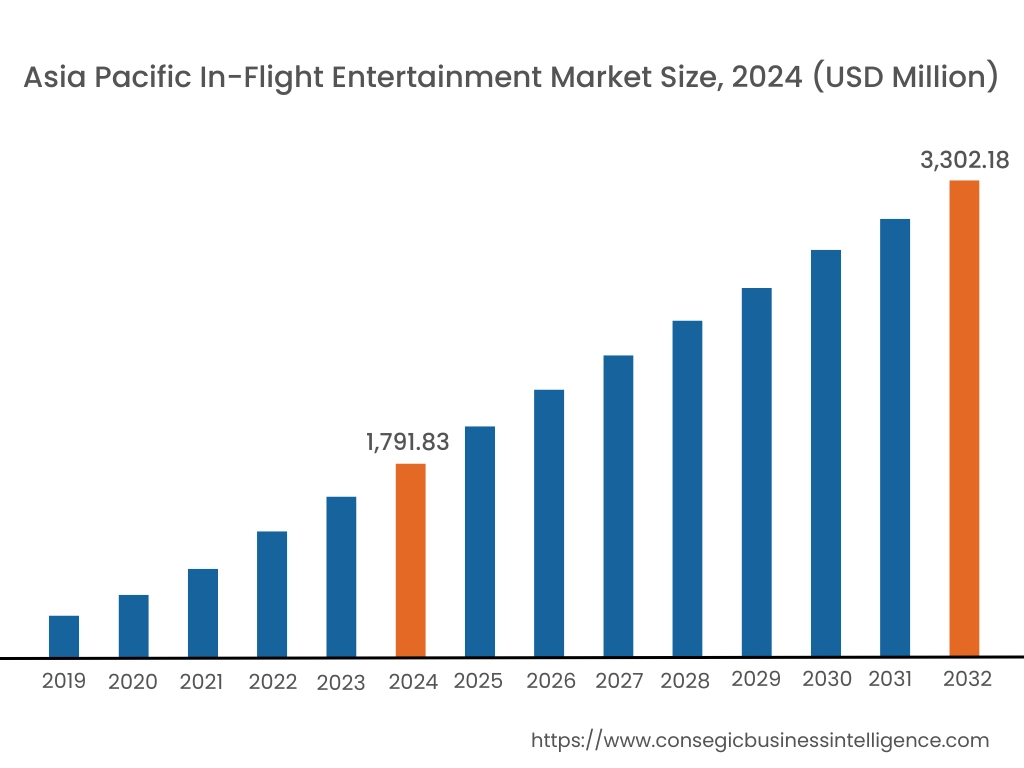
The Asia Pacific region was valued at USD 1,791.83 Million in 2024. Moreover, it is projected to grow by USD 1,901.16 Million in 2025 and reach over USD 3,302.18 Million by 2032. Out of this, China accounted for the maximum revenue share of 28.3%. The market progress is mainly driven by rising government initiatives to expand infrastructural development. Furthermore, factors including a growing middle class and increasing investment in aviation infrastructure are projected to drive the market progress in the Asia Pacific region during the forecast period.
- For instance, in November 2023, Moment partnered with Nok Air to enhance the in-flight experience for passengers. The partnership aims to leverage digital expertise to provide passengers with a more engaging and personalized travel experience.
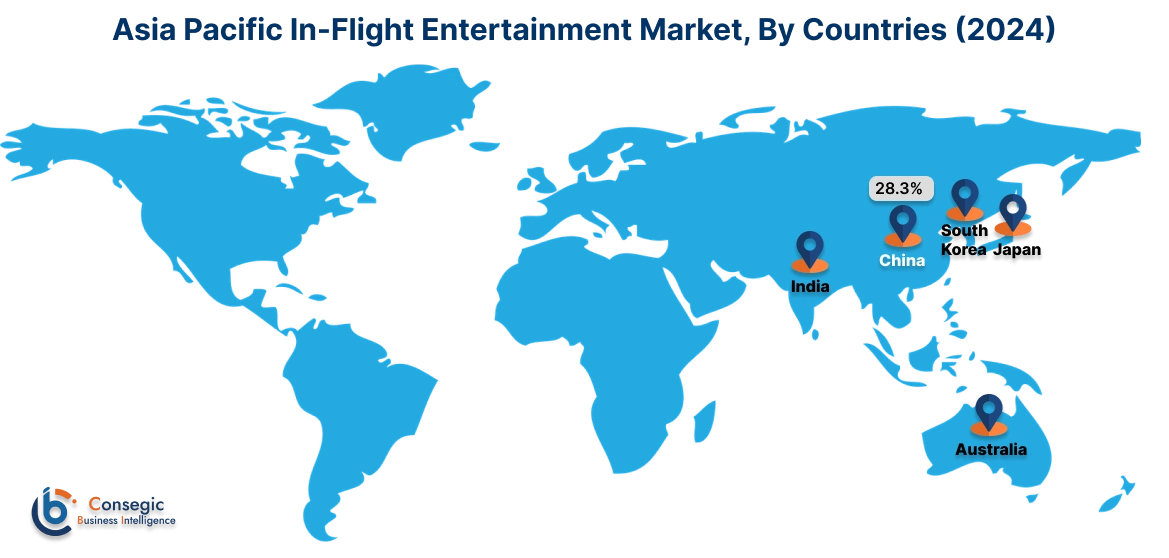
North America is estimated to reach over USD 4,100.02 Million by 2032 from a value of USD 2,284.97 Million in 2024 and is projected to grow by USD 2,418.97 Million in 2025. The North American region's strong airline industry and technological advancements offer lucrative growth prospects for the market. Additionally, the rising investment in providing in-flight entertainment is driving the market progress.
- For instance, according to the Air Transport Action Group, 4.7% of all employment contributes to 4.7% of all GDP in the United States and Canada in 2023.
The regional analysis depicts that the increasing need for personalized, high-speed internet access and advanced connectivity technologies is driving the market in Europe. Additionally, the key factor driving the market is the rising focus on personalization, high-speed connectivity, and others is propelling the market adoption in the Middle East and African region. Further, the expanding 5G network is paving the way for the progress of the market in the Latin American region.
Top Key Players and Market Share Insights:
The global in-flight entertainment market is highly competitive, with major players providing in-flight entertainment to the national and international markets. Key players are adopting several strategies in research and development (R&D), product innovation, and end user launches to hold a strong position in the in-flight entertainment industry. Key players in the in-flight entertainment market include-
- BAE Systems (UK)
- Panasonic Avionics (Japan)
- Astronics CSC (USA)
- Collins Aerospace (USA)
- Bluebox Aviation Systems (UK)
- Honeywell International Inc. (USA)
- ViaSat Inc. (USA)
- Gogo Business Aviation (USA)
- Lufthansa Group (Germany)
- Thales (France)
- Moment Tech (USA)
Recent Industry Developments :
Merger & Acquisition:
- In December 2024, Gogo acquired Satcom Direct to leverage the in-flight connectivity solutions across various segments, including business aviation and government mobility.
- In October 2024, Moment acquired Airfree, a specialist in in-flight e-commerce. The acquisition aims to strengthen the company's position in providing experience and innovative solutions for the transportation sector.
Market Expansion:
- In July 2024, Panasonic Avionics strengthened its presence in India with the launch of a new software design and development center in Pune.
In-Flight Entertainment Market Report Insights :
| Report Attributes | Report Details |
| Study Timeline | 2019-2032 |
| Market Size in 2032 | USD 11,081.13 Million |
| CAGR (2025-2032) | 8.4% |
| By Component |
|
| By Deployment |
|
| By Aircraft Type |
|
| By Region |
|
| Key Players |
|
| North America | U.S. Canada Mexico |
| Europe | U.K. Germany France Spain Italy Russia Benelux Rest of Europe |
| APAC | China South Korea Japan India Australia ASEAN Rest of Asia-Pacific |
| Middle East and Africa | GCC Turkey South Africa Rest of MEA |
| LATAM | Brazil Argentina Chile Rest of LATAM |
| Report Coverage |
|
Key Questions Answered in the Report
How big is the In-Flight Entertainment Market? +
The In-Flight Entertainment Market is estimated to reach over USD 11,081.13 Million by 2032 from a value of USD 6,146.29 Million in 2024 and is projected to grow by USD 6,509.29 Million in 2025, growing at a CAGR of 8.4% from 2025 to 2032.
What specific segmentation details are covered in the In-Flight Entertainment report? +
The In-Flight Entertainment report includes specific segmentation details for component, deployment, aircraft type, and regions.
Which is the fastest segment anticipated to impact the market growth? +
In the In-Flight Entertainment Market, the business jet is the fastest-growing segment during the forecast period due to the rising demand for luxury and personalized experiences, technological advancements, growing focus on productivity, and increasing disposable income among high-net-worth individuals.
Who are the major players in the In-Flight Entertainment Market? +
The key participants in the In-Flight Entertainment Market are BAE Systems (UK), Panasonic Avionics (Japan), ViaSat Inc. (US), Gogo Business Aviation (US), Lufthansa Group (Germany), Thales (France), Moment Tech (US), Astronics CSC (US), Collins Aerospace (US), Bluebox Aviation Systems (UK), Honeywell International Inc. (US), and others.
What are the key trends in the In-Flight Entertainment Market? +
The In-Flight Entertainment Market is being shaped by several key trends including trend towards increased demand for high-speed connectivity, focus on personalized experiences, rise of bring-your-own-device (BYOD) solutions, and advancements in technology among others are the key trends driving the market.
